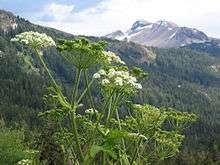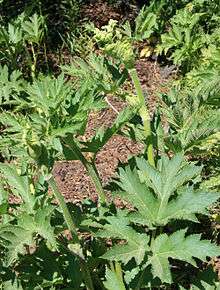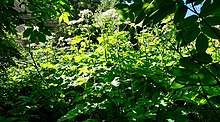Heracleum maximum
| Heracleum maximum | |
|---|---|
 | |
| Cow parsnip | |
| Scientific classification | |
| Kingdom: | Plantae |
| Clade: | Angiosperms |
| Clade: | Eudicots |
| Clade: | Asterids |
| Clade: | Campanulids |
| Order: | Apiales |
| Family: | Apiaceae |
| Genus: | Heracleum |
| Species: | H. maximum |
| Binomial name | |
| Heracleum maximum | |
| Synonyms | |
|
Heracleum lanatum Michx. | |
Heracleum maximum, commonly known as cow parsnip, is the only member of the genus Heracleum native to North America. H. maximum is also known as Indian celery, Indian rhubarb or pushki.
Taxonomy
According to The Plant List, Heracleum maximum is an accepted species name[2] but the species has no synonyms or infraspecific taxa. On the other hand, Heracleum maximum is not recognized as an accepted name by either the Integrated Taxonomic Information System (ITIS) or the National Plant Germplasm System (NPGS). According to ITIS and NPGS, both Heracleum maximum and Heracleum lanatum are synonyms for Heracleum sphondylium subsp. montanum.[3][4] These three names are often used interchangeably in the literature, which has caused some difficulty and confusion.
The classification given here follows The Plant List, that is, each of Heracleum maximum, Heracleum lanatum, and Heracleum sphondylium subsp. montanum is a distinct species.[2][5][6]
Distribution
Cow parsnip is distributed throughout most of the continental United States except the Gulf Coast and a few neighboring states. It occurs from sea level to elevations of about 2,700 metres (9,000 ft).[7] It is especially prevalent in Alaska, where it is often found growing amongst plants like devil's club, which is nearly identical in size and very similar in appearance, and monkshood, a very toxic flower. In Canada, it is found in every province and territory except Nunavut. It is listed as "Endangered" in Kentucky and "Special Concern" in Tennessee.[8]
Characteristics
Cow parsnip is a tall herb, reaching to heights of over 2 metres (7 ft). The genus name Heracleum (from "Hercules") refers to the very large size of all parts of these plants.[9] Cow parsnip has the characteristic flower umbels of the carrot family (Apiaceae). The umbels are about 20 centimetres (8 in) across, flat-topped or rounded, and composed of small white flowers. Sometimes the outer flowers of the umbel are much larger than the inner ones. The leaves are very large, up to 40 cm (16 in) across, and divided into lobes. The stems are stout and succulent. The seeds are 8–12 mm (0.3–0.5 in) long and 5–8 mm (0.2–0.3 in) wide.[7]
The stems and leaves contain furocoumarins, chemicals responsible for the characteristic rash of erythematous vesicles (burn-like blisters) and subsequent hyperpigmentation that occurs after getting the clear sap onto one's skin. The chemical is photosensitive,[10] with the rash occurring only after exposure to ultraviolet light. Because of this, phytophotodermatitis may occur after cutting or mowing the plants on a sunny day.
It is commonly confused with Heracleum mantegazzianum (giant hogweed),[11] which is a much larger plant that typically has purplish spots on the stems, as well as more sharply serrated leaves.[12]

Uses
Indigenous North Americans have had a variety of uses for cow parsnip. It could be an ingredient in poultices applied to bruises or sores. The young stalks and leaf stems were used for food once the outer skin was peeled off. The dried stems were used as drinking straws for the old or infirm, or made into flutes for children.
An infusion of the flowers can be rubbed on the body to repel flies and mosquitoes. A yellow dye can be made from the roots.[13]
See also
- Heracleum, the genus
- Other non-invasive Heracleum species: Heracleum sphondylium
- Tall invasive Heracleum species: Heracleum mantegazzianum, Heracleum sosnowskyi, and Heracleum persicum
- Other plants commonly mistaken for Heracleum maximum:[11] wild carrot, cow parsley, Angelica species, poison hemlock, wild parsnip
References
- ↑ "Heracleum maximum". ipni.org. International Plant Names Index. Retrieved 2018-09-20.
- 1 2 "Heracleum maximum W. Bartram". The Plant List, Version 1.1. 2013. Retrieved September 21, 2018.
- ↑ "Heracleum sphondylium ssp. montanum (Schleich. ex Gaudin) Briq". Integrated Taxonomic Information System. Retrieved September 21, 2018.
- ↑ "Taxon: Heracleum sphondylium L. subsp. montanum (Schleich. ex Gaudin) Briq". Germplasm Resources Information Network. United States Department of Agriculture, Agricultural Research Service. Retrieved September 21, 2018.
- ↑ "Heracleum lanatum Michx". The Plant List, Version 1.1. 2013. Retrieved September 21, 2018.
- ↑ "Heracleum sphondylium subsp. montanum (Schleich. ex Gaudin) Briq". The Plant List, Version 1.1. 2013. Retrieved September 21, 2018.
- 1 2 Norman F. Weeden (1996), A Sierra Nevada Flora, Wilderness Press, ISBN 0-89997-204-7
- ↑ "Heracleum maximum". Natural Resources Conservation Service PLANTS Database. USDA. Retrieved 2008-03-30.
- ↑ Elizabeth L. Horn (1998), Sierra Nevada Wildflowers, Mountain Press, ISBN 0-87842-388-5
- ↑ Meades, S.J.; Schnare, D.; Lawrence, K.; Faulkner, C. "Heracleum maximum W.Bartram". Northern Ontario Plant Database. Algoma University College and Great Lakes Forestry Centre, Sault Ste. Marie, Ontario, Canada. Retrieved 8 October 2018.
- 1 2 "Heracleum maximum: Similar Species". iNaturalist.org. iNaturalist. Retrieved 2018-08-26.
- ↑ "Giant Hogweed, Heracleum mantegazzianum". maine.gov. State of Maine: Department of Agriculture, Conservation, and Forestry. Retrieved 2018-08-26.
- ↑ "BRIT - Native American Ethnobotany Database". herb.umd.umich.edu.
External links
| Wikimedia Commons has media related to Cow Parsnip. |

- Jepson Manual species treatment
- Heracleum maximum in the CalPhotos Photo Database, University of California, Berkeley
- Images from the Connecticut Botanical Society
- Plants for a Future report on the species